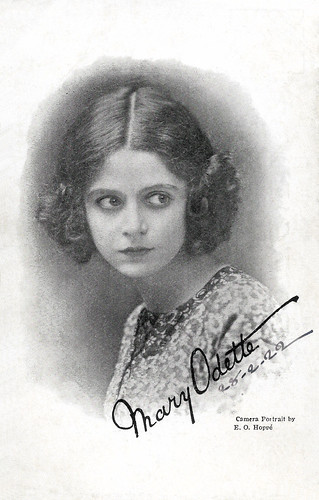
British postcard. Photo: E.O. Hoppé. Sent by mail in 1922.
Mary Odette (1901-1987) was a French actress who starred in British, Dutch, German, and French silent films.

German postcard by Ross Verlag, Berlin, no. 3295/1, 1928-1929. Photo: E.O. Hoppé, London. Collection: Didier Hanson.
Despite her French name, Lucy Doraine (1898-1989) was a major Hungarian actress in the Austrian and German cinema of the 1920s. When she moved to Hollywood, the revolution of the sound film finished her career.
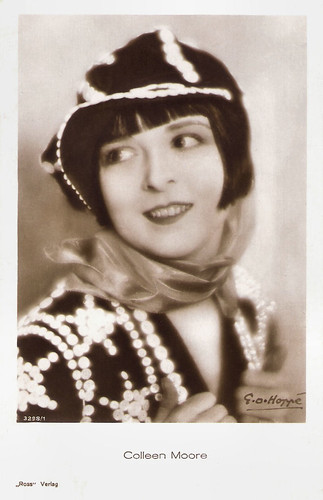
German postcard by Ross Verlag, no. 3298/1, 1928-1929. Photo: E.O. Hoppé.
American actress Colleen Moore (1899-1988) was a star of the silent screen who appeared in about 100 films beginning in 1917. During the 1920s, she put her stamp on American social history, creating in dozens of films the image of the wide-eyed, insouciant flapper with her bobbed hair and short skirts.

German postcard by Ross Verlag, Berlin, no. 4048/1, 1929-1930. Photo: E.O. Hoppé, London.
Evelyn Holt (1908-2001) was a highly popular German film actress in the late silent and early sound era.
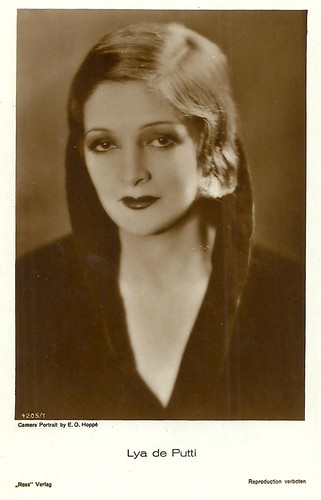
German postcard by Ross Verlag, no. 4205/1, 1929-1930. Photo: E.O. Hoppé.
Lya de Putti (1899-1931) portrayed vamps in German and American silent films.
Increasingly enamoured with photography
Emil Otto Hoppé (1878-1972) was born to a wealthy family in Munich. He was the only son of a prominent banker and was educated in schools in Munich, Paris and Vienna. Upon leaving school he served apprenticeships in German banks. In 1900, he accepted a position with the Shanghai Banking Corporation. He never arrived in China. The first leg of his journey took him to England where he met an old school friend and Hoppé decided to stay in London. While working for the Deutsche Bank, he became increasingly enamoured with photography and in 1903, he joined the Royal Photographic Society. In 1905, Hoppé married his old school friend's sister, Marion Bliersbach, and in 1907, he jettisoned his commercial career and opened a portrait studio.
From 1907 to 1911 he worked in London together with E. F. Griffin as a portrait photographer. Within a few years, E.O. Hoppé was one of the leaders of pictorial portraiture in Europe. He organised numerous exhibitions. His reputation attracted many important British and North American figures in politics, literature, and the arts. In 1909, he represented Great Britain at the International Photography Exhibition in Dresden. The following year, 70 portrait photographs by Hoppé were shown at an exhibition of the Royal Photographic Society. This was the first exhibition the Society dedicated to a single photographer. In the era before the First World War, Hoppé photographed such celebrities as Henry James, Rudyard Kipling, John Masefield, Léon Bakst, Anna Pavlova, Vaslav Nijinsky and other dancers of the Ballets Russes, and Richard Strauss. By 1919, Hoppé also had begun to travel the world in search of new subjects and landscapes. His journeys brought him to Africa, Germany, Poland, Romania, Czechoslovakia, the United States, Cuba, Jamaica and the West Indies, Australia, New Zealand, Japan, Indonesia, Singapore, Malaya, India and Ceylon. The resulting photographs were published in a number of books.
In 1921 he photographed portraits of King George V and Queen Mary at Buckingham Palace, which were distributed worldwide as postcards and posters. His other subjects of the 1920s included Albert Einstein, Benito Mussolini, Aldous Huxley, George Bernard Shaw and A.A. Milne. In 1928 Hoppé travelled to Germany and did many portrait sittings in Berlin. He also made photographs for the Ufa film studio. His photographs were presented in two books that were published in Germany in the next few years. In the 1930s Hoppé photographed a number of dancers at the Vic-Wells company including Margot Fonteyn and Ninette de Valois. Hoppé also made portraits of the street types of London: he photographed English cleaners, maids, and street vendors both in his studio and on the street. He continued this practice of capturing ordinary working men and women throughout his career as he travelled throughout the world.
In 1954, at the age of 76, Emil Otto Hoppé sold his body of photographic work to a commercial London picture archive, the Mansell Collection. In the collection, the work was filed by the subject with millions of other stock pictures and was no longer accessible by the author. Almost all of Hoppé's photographic work was accidentally obscured from photo-historians and from photo-history itself. Hoppé died in London in 1972 at the age of 94.
Hoppé's photos remained in the Mansell collection for decades after his death, until the collection closed down and was acquired by new owners in the United States. In 1994 photographic art curator Graham Howe retrieved Hoppé's photographic work from the picture library and rejoined it with the Hoppé family archive of photographs and biographical documents. This was the first time since 1954 that the complete E.O. Hoppé Collection was gathered together. Many years were spent in cataloguing, conservation, and research of the recovered work. Hoppé published a number of books including 'The Book of Fair Women' (1922), 'Taken from Life' (1922) and 'London Types' (1926) and his autobiography 'Hundred Thousands Exposures' (1945).

German postcard by Ross Verlag, no. 4227/3, 1929-1930. Photo: E.O. Hoppé, London.
Willy Fritsch (1901-1973) was the immensely popular ‘Sunny Boy’ of the Ufa operettas of the 1930s and 1940s.

German postcard by Ross Verlag, no. 4228/1, 1929-1930. Photo: E.O. Hoppé, London.
Russian actor Ivan Mozzhukhin (in French Ivan Mosjoukine and in German Iwan Mosjukin) (1889-1939) was a legendary star of the European silent film, who shone in Russia, France, Germany and Austria, but suffered in Hollywood.

German postcard by Ross Verlag, Berlin, no. 4372/1, 1929-1930. Photo: E.O. Hoppé, London.
Pretty Austrian actress Jenny Jugo (1904-2001) appeared in more than fifty films between 1925 and 1950. Towards the end of the silent era, she fared well in comedies and this trend continued into the 1930s. She starred between 1931 and 1942 in eleven smart and charming comedies directed by Erich Engel.
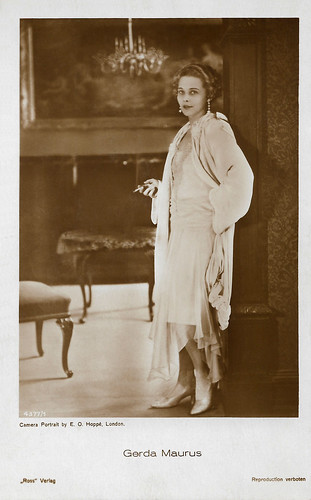
German postcard by Ross Verlag, Berlin, no. 4377/1, 1929-1930 Photo: E.O. Hoppé, London.
Austrian actress Gerda Maurus (1903-1968) was a star of the silent screen. With her protruded cheekbones and her forceful look, she bewitched many men, including her director Fritz Lang and Nazi Minister Josef Goebbels.

German postcard by Ross Verlag, Berlin, no. 4380/1, 1929-1930. Photo: E.O. Hoppé, London.
German actress Brigitte Helm (1908-1996) is still famous for her dual role as Maria and her double the evil Maria, the Maschinenmensch, in the silent SF classic Metropolis (Fritz Lang, 1927). After Metropolis she made a string of over 30 films in which she almost always had the starring role. She easily made the transition to sound films, before she abruptly retired in 1935.
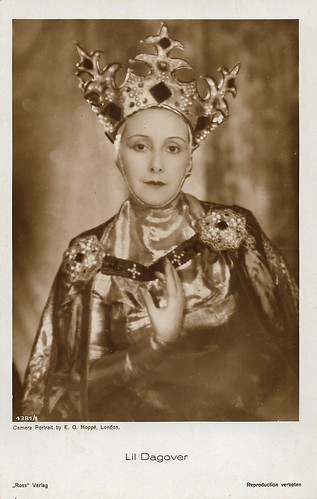
German postcard by Ross Verlag, no. 4381/1, 1929-1930. Photo: E.O. Hoppé, London.
German, but Dutch-born film actress Lil Dagover (1887-1980) was an exotic, dark beauty, who featured prominently during the golden age of the German silent cinema. She had her breakthrough as the prey of Dr. Caligari's monster in the classic expressionist film Das Cabinet des Dr. Caligari (1920) but gradually her fine and evanescent beauty changed and she turned into a 'Salondame', a lady of the screen. Her career would span nearly six decades.
Sources: National Portrait Gallery, E.O. Hoppé.com, Wikipedia (English and German).
No comments:
Post a Comment